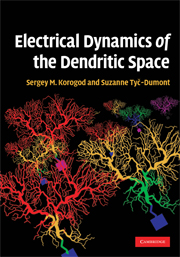Book contents
- Frontmatter
- Contents
- Preface
- 1 Definition of the neuron
- 2 3D geometry of dendritic arborizations
- 3 Basics in bioelectricity
- 4 Cable theory and dendrites
- 5 Voltage transfer over dendrites
- 6 Current transfer over dendrites
- 7 Electrical structure of an artificial dendritic path
- 8 Electrical structure of a bifurcation
- 9 Geography of the dendritic space
- 10 Electrical structures of biological dendrites
- 11 Electrical structure of the whole arborization
- 12 Electrical structures in 3D dendritic space
- 13 Dendritic space as a coder of the temporal output patterns
- 14 Concluding remarks
- Index
- References
13 - Dendritic space as a coder of the temporal output patterns
Published online by Cambridge University Press: 03 May 2010
- Frontmatter
- Contents
- Preface
- 1 Definition of the neuron
- 2 3D geometry of dendritic arborizations
- 3 Basics in bioelectricity
- 4 Cable theory and dendrites
- 5 Voltage transfer over dendrites
- 6 Current transfer over dendrites
- 7 Electrical structure of an artificial dendritic path
- 8 Electrical structure of a bifurcation
- 9 Geography of the dendritic space
- 10 Electrical structures of biological dendrites
- 11 Electrical structure of the whole arborization
- 12 Electrical structures in 3D dendritic space
- 13 Dendritic space as a coder of the temporal output patterns
- 14 Concluding remarks
- Index
- References
Summary
The dendritic job to process synaptic inputs ends by generating patterns of output discharges. If the site of initiation of action potentials has long been known, the mechanisms by which the axo-somatic trigger zone is finally put into action is an open question. A 60-year-old large consensus admits the simple explanation: the current shifts the voltage at the initial segment and when a threshold is reached, the neuron fires. The reasons for the numerous different types of output patterns observed from a single neuron are skipped and remain unknown. How the output patterns are formed by the electrical dendritic arborization with non-linear, active membrane is explained in this chapter.
We select two types of neurons with clearly different geometry and cocktails of voltage-dependent channels in their dendrites, and simulate generation of output discharge patterns in response to tonic activation of synaptic inputs distributed over the dendritic membrane to find out the rules that govern the neuronal code.
Terminology to describe the repertoire of neuronal discharges
We propose the following terminology to describe the types of electrical activity of neurons that we observe in our models.
Elementary electrical event at the neuron output (axon) is a single action potential (spike) or a burst of action potentials. Other examples of elementary events recorded from the soma or dendrites are slow depolarization waves or postsynaptic potentials.
Burst of action potentials is a group of sequential action potentials separated by the same or different time intervals, the duration of which is compatible with the refractoriness period. Examples are groups of two (doublet), three (triplet) or four (quadruplet) action potentials.
- Type
- Chapter
- Information
- Electrical Dynamics of the Dendritic Space , pp. 173 - 196Publisher: Cambridge University PressPrint publication year: 2009



